Colorblock Jute Stitch Blanket
When you say “waffle” to knitters, before we think of syrup-laden breakfast, we think texture. Waffle, with its grid of ridges and hollowed-out boxes, just screams lofty, soft, and cozy, and our Colorblock Jute Stitch Blanket is one big ode to this kind of waffle-y goodness!
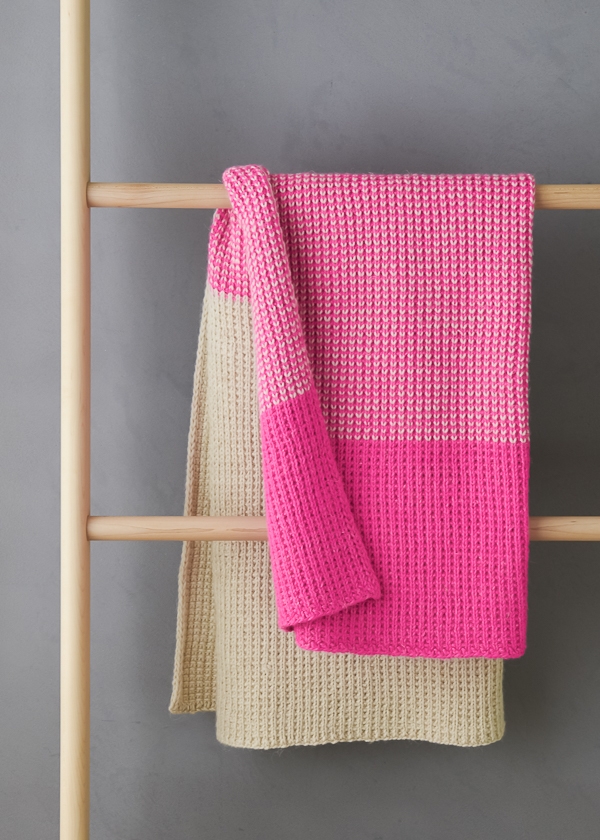
The stitch pattern is called jute stitch (no, nothing to do with cushion-y waffles!), a super easy slip-stitch pattern. The idea is simple. Start with a block of one color, then alternate two colors to create a beautiful speckled band, and finish with a block of your second shade.

Okay, so we’ve got waffles, jute (?!), and color blocks, let’s add into the mix our newest yarn, Linen Quill Worsted. Everything you love about our classic Linen Quill, this new worsted weight makes the knitting speedier, the stitches more in-your-face, and the fabric plumper.

Pick a color duo from our palette of 28 gorgeous colors, then decide on a size: crib or throw, and finally, get to knitting your waffled, color-blocked, jute-stitch blanket in Linen Quill Worsted!
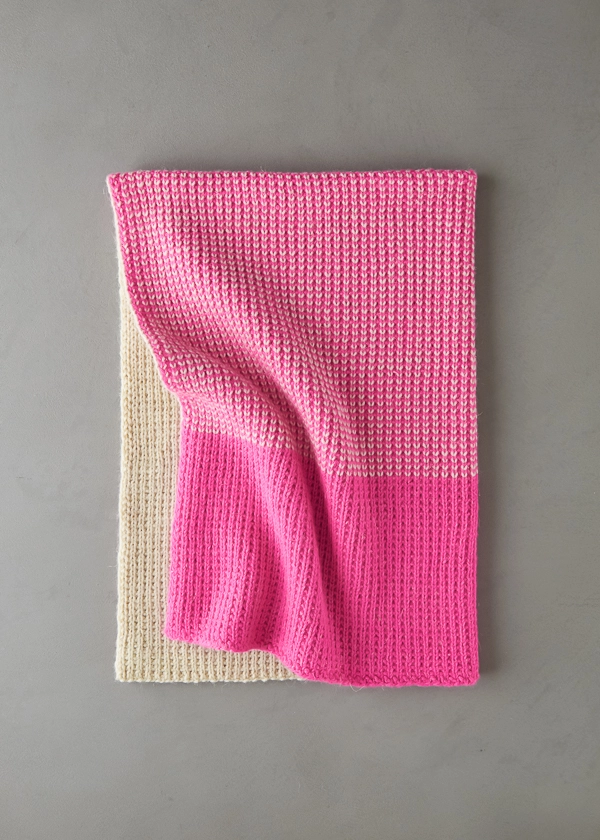
Designed by Purl Soho designer, Jake Canton. Click here to see even more of Jake’s designs!
Share your progress + connect with the community by tagging your pics with #PurlSoho, #PurlSohoBusyHands, #PurlSohoColorblockJuteStitchBlanket, and #PurlSohoLinenQuillWorsted. We can’t wait to see what you make!
Materials
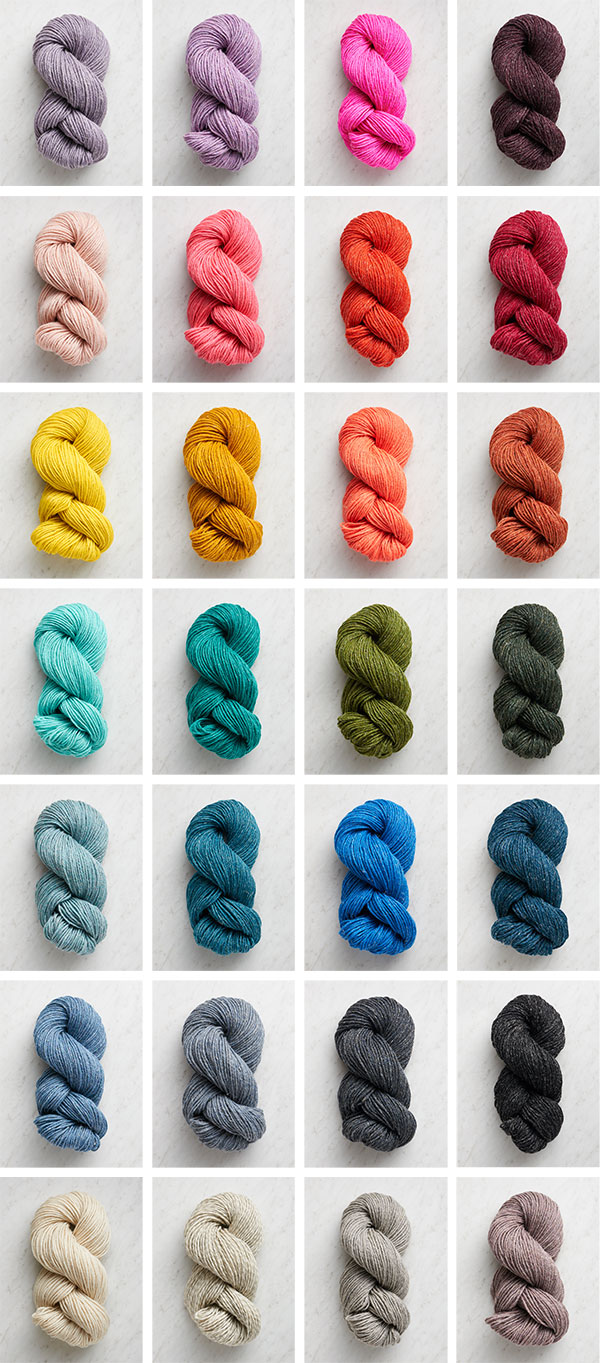
- Color A: 3 (6) skeins of Purl Soho’s Linen Quill Worsted, 50% fine highland wool, 35% alpaca, and 15% linen. Each skein is 164 yards; approximately 459 (984) yards required. We used the color Pink Pop. (NOTE: We no longer offer Linen Quill Worsted, but choose from one of our other worsted weight yarns.)
- Color B: 4 (8) skeins of Linen Quill Worsted. Approximately 592 (1,286) yards required. We used the color Pale Oats. (NOTE: We no longer offer Linen Quill Worsted, but choose from one of our other worsted weight yarns.)
- US 8 (5 mm), 32- or 40-inch circular needles
Gauge
22 stitches and 32 rows = 4 inches in stitch pattern
Sizes
Crib (Throw)
Finished Dimensions: 30 inches wide x 39 inches long (42 inches wide x 55 inches long)
Sample: The blanket shown here is the Crib size.
Notes
Stitch Multiple
This pattern works over any odd number of stitches.
Slip Stitches
Slip all slipped stitches purlwise.
Turn + Slide
When you work the Two-Color Jute Stitch Pattern, you either “slide” or “turn” the work at the end of each row.
“Turn work” means to do what you would normally do when knitting rows with circular needles: Transfer the needle from your left hand into your right hand and the needle from your right hand into your left, flipping the work around so the opposite side is facing you.
“Slide work” means to keep the same side of the work facing you and to push all the stitches to the right end of the circular needles. Without turning the work, start the new row as you normally would.
You will know that you’re doing this right if the yarn you need to complete the next row is right there waiting for you!
Pattern
With Color A, cast on 165 (231) stitches. We used a basic Long Tail Cast On.
One-Color Jute Stitch
Row 1 (wrong side): Slip 1 with yarn in front (wyif), *k1, p1, repeat from * to last 2 stitches, k1, slip 1 wyif.
Row 2 (right side): K1, slip 1 wyif, *k1, slip 1 with yarn in back (wyib), repeat from * to last 3 stitches, k1, slip 1 wyif, k1.
Repeat Rows 1 and 2 until piece measures 8 (11) inches from cast-on edge, ending with Row 2.
Two-Color Jute Stitch
Set-Up Row (wrong side): With Color A, slip 1 wyif, *k1, p1, repeat from * to last 2 stitches, k1, slip 1 wyib. Turn work.
Join Color B.
Row 1 (right side): With Color B, k1, slip 1 wyif, *k1, slip 1 wyib, repeat from * to last 3 stitches, k1, slip 1 wyif, k1. Slide work.
Row 2 (right side): With Color A, slip 1 wyif, *p1, k1, repeat from * to last 2 stitches, p1, slip 1 wyif. Turn work.
Row 3 (wrong side): With Color B, p1, slip 1 wyib, *p1, slip 1 wyif, repeat from * to last 3 stitches, p1, slip 1 wyib, p1. Slide work.
Row 4 (wrong side): With Color A, slip 1 wyib, *k1, p1, repeat from * to last 2 stitches, k1, slip 1 wyib.
Repeat Rows 1-4 for 14 (20) inches, ending with Row 4.
Cut Color A.
One-Color Jute Stitch
With Color B…
Row 1 (right side): K1, slip 1 wyif, *k1, slip 1 with yarn in back (wyib), repeat from * to last 3 stitches, k1, slip 1 wyif, k1.
Row 2 (wrong side): Slip 1 with yarn in front (wyif), *k1, p1, repeat from * to last 2 stitches, k1, slip 1 wyif.
Repeat Rows 1 and 2 for 17 (24) inches, ending with Row 2. [Piece measures 39 (55) inches from cast-on edge]
Bind-Off Row (right side): K1, *p1, pass first stitch over, k1, pass first stitch over, repeat from * to end of row.
Weave in the ends and wet block.
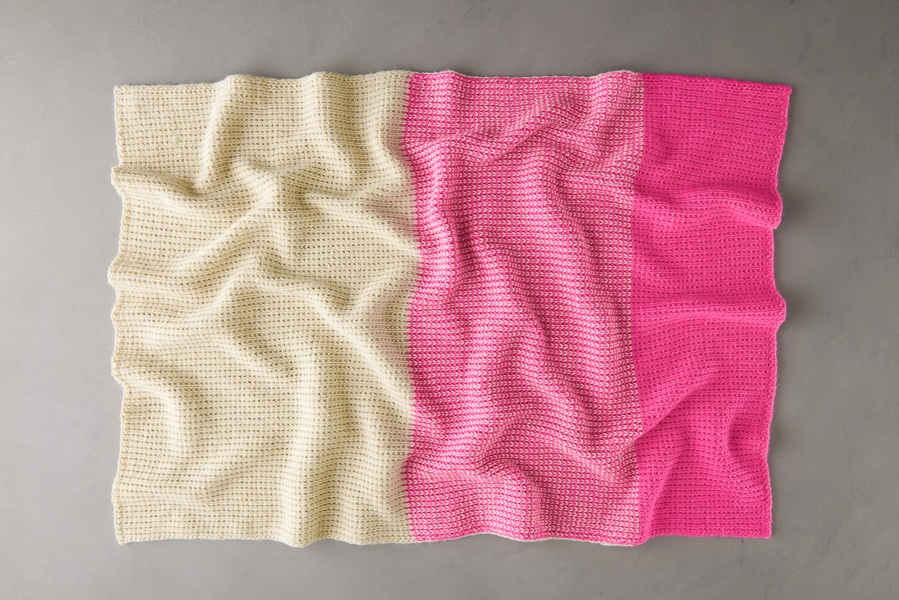





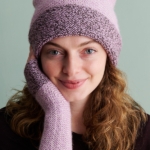
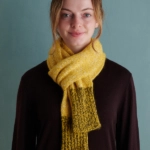

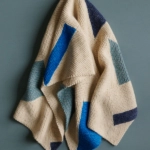
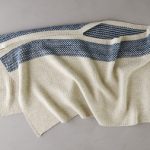
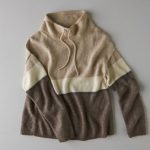
Hi, can I do this stitch with straight needles if using less stitches? Thank you
Hi and thanks for reaching out! While you could do the single color portions of this blanket on straight needles, you do need to have a circular needle to work the two-color jute stitch, since you will sometimes have to slide your stitches to the other end of the needle.
I hope that clears things up!
Julianna
No, the dual colour section requires you to slide the work to use the yarn efficiently
I love many of your blankets but don’t dare make one going to a young person, as most of the yarns you use need special attention. So would you occasionally mention another yarn you carry that could be machine washed and dried.
Thanks
Hi Mary Jane,
Thanks so much for writing in! We are always happy to recommend alternative yarns! In this case, I would suggest using Blue Sky Worsted Cotton. We have had great success washing and drying blankets and other items made from this yarn, and it has the exact same yardage as Linen Quill Worsted, so you can order the same number of skeins as is listed above.
Happy knitting!
Julianna
Hi Julianna,
I ordered the Blue Sky Worsted Cotton which has just arrived. It’s so soft! This will be a gift for a baby – is it safe to machine wash (if so, on what temperature?) or is it handwash only? Thanks!
Hi Caitlin,
I’m so glad you like it! Although the official washing instructions on the label are to hand wash and lay flat to dry, we have machine washed and dried many baby items knit out of Blue Sky Worsted Cotton with fantastic results. I would probably stick with a cool or cold wash and low heat in the dryer. You may find that it sheds a fair amount the first time it goes through the dryer, but the shedding should stop after the first wash or two.
Best,
Julianna
Thanks for your reply, much appreciated!
I like this blanket very much. I see the yarn requirements are given for the crib-sized blanket. Is the yarn specifications also given for the throw size? Are they two different things? And, my apologies if the throw yarn is included here and I missed it.
Thank you.
Hi Carol,
Thanks so much for the kind words and for reaching out! The yarn amounts for the throw size are given in parentheses after the amounts for the crib size, so you will need 6 skeins of Color A and 8 skeins of Color B for the throw size.
Happy knitting!
Julianna
There are really long double-pointed needles out there, usually made in Germany, so you could always try to work the blanket on them if you don’t like circular needles. Put point protectors on the ends so that your stitches won’t fall off.
Hi, is this a beginner friendly pattern? It’s a lot of $$$ yarn to invest if I’m not skilled enough to execute…I practiced a little with some wool on straight needles, without much success, but I suspect it’s very different on round needles?
Also, is the 40” specifically for the throw? Or could you do that on a 32” too? You’re just out of the 40” bamboo, and it’s my understated they are easier for beginners? And advice welcome.
Thank you
Stay well.
Hi and thanks for reaching out! Yes, this is a very beginner friendly pattern! This blanket only basic stitches – knitting, purling, and slipping stitches, which just means moving a stitch from the left needle to the right needle without working it – so the stitch is very easy to master. Because this is knit flat and not in the round, there shouldn’t be any difference between knitting it on circular or straight needles, so you might just need a bit more practice to get the hang of the stitch.
You could use either the 32″ or 40″ blanket for the throw size blanket. The width of the finished blanket is 42 inches, which will still squish up to fit comfortably on a 32″ needle. Most beginners do prefer bamboo needles because they have a bit more grip so your stitches feel more secure, but you could always give metal needles a try! Many knitters find that the super slick metal of Addi and Addi Turbo needles allows them to knit much faster.
I hope that helps, and happy knitting!
Julianna
I just started my color B. Wondering if my wrong side should be looking like a Color A field with Color B lines through it horizontally? I can’t tell if any of your photos are meant to show the wrong side? My right side looks like the photos.
Thanks!
Hi Bgray,
Yes, you are correct! The wrong side of the center section will have horizontal lines – you’re doing it right!
Happy Knitting!
Cassandra
I cannot figure out what I am doing wrong, but when I start the two color stitch, the Color B stitches are not in a straight line – they are staggered. Any ideas?
Hi Sarah,
Thanks so much for reaching out with this question! Not to worry, what you described sounds like what you can expect when knitting the Two-Color Jute Stitch. You’ll know you’re on the right track if your completed Row 1 stitches are alternating colors: Color B for the k1’s and Color A for the slipped stitches.
I hope that helps!
Gaby
Hey! So I’m just about to begin the 3rd portion of this adorable blanket and the instructions say to end the 2nd portion with row 1, which is a right side row. Row 1 for the 3rd section is also a right side row. Is my pregnancy brain playing tricks on me? What am I missing?
Hi Katie,
Thank you so much for letting us know about this typo in the pattern! You’re right, the Two-Color Jute Stitch section should end with Row 4, which is a wrong side row. We have fixed the error and you can view an updated version above!
Warmly,
Gaby
for 1 color jute – do I double the yarn or just use it single, as 2 color is doubled… thanks.
Hi Jodi,
Thanks for writing in! If you’d prefer a solid color blanket you may follow the One-Color Jute Stitch instructions until you reach the finished length. The Two-Color Jute stitch alternates between colors, as opposed to holding both colors together, so you’re always using just a single strand of yarn throughout the pattern. I hope this helps!
Happy knitting!
Gaby
Hi Jodi,
Thanks for asking! The one-color Jute Stitch uses a single strand of our Linen Quill Worsted, while the two-color section alternates rows with color A and color B. You’ll only be using one yarn per row, whether you work the one-color or the two-color sections. I hope this helps!
Happy Knitting!
Cassandra
Can you post pictures of the finished wrong side of that pretty pink sample blanket? I started my blanket with A and B swapped. Would like to see what the correct two-color panel looks like from the back. Thanks!
Hi Marybeth,
Thanks for asking about this! If you look along the top bar of photos (scrolling through with the arrow on the right) you’ll see one of the photos of the blanket on a wooden rack with the edge turned back to show both sides. There are two, one closer up than the other, which should give you a good idea of what the middle section looks like on the back. I hope this helps!
Best,
Cassandra
Hi, again,
I don’t believe that’s the wrong side…I think that blanket is folded in thirds and the edge that’s turned is actually still the right side. My wrong side looks striped. The front side has the knit “dots” but the back side of the two-color panel looks different. I was trying to get an idea of what the darker color as A and lighter color as B looks like but it’s ok. Thanks though!
Hi Marybeth,
My apologies, I think you’re correct! Unfortunately, I don’t have access to the blanket for photos of the back at this point in time, and it doesn’t look like any were taken during the photoshoot. If I have the opportunity to get a photo, I’ll let you know! Again, sorry for that! I’m sure yours will be fine – carry on and keep knitting!
Best,
Cassandra
Any way to see a video on this? I’m new to knitting and would love to make this for a friend’s baby arriving in August.
Hi Tam,
Thanks for asking about this! I’m sorry that we don’t have the resources right now to create a video for this project and specific stitch. Our Big Good Blanket uses super simple Seed Stitch, and has a similar gradient effect. You can also browse through all of our blanket projects here –
I hope this helps – happy knitting!
Cassandra
My swatch rolls right up. I’m hoping the larger scale of the blanket and blocking will remedy, but I’d hate to knit the whole thing and bug driven bonkers by rolling edges. Any advice on how to get this stretch pattern to lay flat?
Hi Monica,
Thank you for reaching out! I completely understand your concern- as knitters we do our very best to avoid any curling or rolling edges whenever possible. I think in this case a good blocking should work perfectly to smooth out your swatch! We recently made this helpful tutorial on How To Hand Wash A Sweater, but this is the same process we follow for blocking pretty much all of our knits. I hope this helps!
Happy knitting!
Gaby
I’m having the same issue and the rolling seems so pronounced that blocking may not help much, but I’m using a superwash yarn because I always like to make baby blankets that are machine washable… so I’m guessing that could be a factor?
Hi Wendy
Thanks for reaching out! The best way to see how a yarn behaves with blocking is to work a gauge swatch in pattern before you start any project. Usually, a good wet block takes care of most curling at the edges when you finish. I hope this helps!
Happy knitting
Jessica
Good afternoon! I’d like to make the throw with the worsted twist US8 needles. Would you still recommend I purchase (6) skeins of color A and (8) skeins of color B?
Thanks!
Maggie
Hi Maggie,
Thanks for reaching out! Yes, you’re correct, the yardage for Worsted Twist is identical to the yardage per skein for Linen Quill Worsted, no math required!
Happy Knitting!
Cassandra
I would like the light color to be whiter. Is there something else I could use as the linen quill worsted doesn’t seem to come in white? Thanks for your help.
Hi Susan,
Thanks for writing in! Unfortunately we don’t carry any yarns that come in a true bleached white, but our Worsted Twist in Heirloom White is several shades lighter than Linen Quill Worsted in Pale Oats, and knits up to the correct gauge for the pattern. I hope it is closer to what you are looking for!
Best,
Julianna
Are you sure that the photos and the pattern match? I just get a regular jute stitch following your pattern and the photos show something more like a variation on a fisherman’s rib.
Thanks
PS love the yarns.
Hi Tracey,
Thanks for writing in! Yes, our sample is knit according to the pattern and is indeed jute stitch! Although I can certainly see the similarities to a Fisherman’s Rib stitch in our images, if you look closely at the pictures that show a peek of the wrong side, you can see that it doesn’t match the right side, as it would in Fisherman’s Rib. It sounds like you are following the pattern correctly!
Happy knitting!
Julianna
Sorry if this is a stupid question but can you please give some instructions about how to join colour b? I’m struggling to understand the two colour section of the pattern
Hi Bek
Thanks for writing in! If you follow the joining a new ball of yarn tutorial for adding color B this should help! You’ll only be using one yarn per row, whether you work the one-color or the two-color sections, and you will know its right if your completed Row 1 stitches are alternating colors: Color B for the k1’s and Color A for the slipped stitches. Hope this answers all your questions!
Happy knitting
Jessica
Thanks for replying 🙂 to alternate the colours am I then needing to re-join the yarn every row?
Hi Bek,
Great question! No, you do not have to re-join your yarn every row! Because you will only be working one row of each color before switching back, you can simply leave your yarn tail at the edge of the work and pick it up again when you need it. Just be careful not to pull on your yarn too tightly when you switch colors so the edges of the blanket don’t pucker!
Best,
Julianna
Thank you, that makes sense! The edges of my two colour jute stitch (Colour B) look very different to my colour A edges. Any ideas about what I might be doing wrong? Sorry for all the questions!
Hi Bek,
I’m glad that cleared things up! The edges should look the same, but they are worked differently because you have to work from both edges of the blanket when knitting the two color stitch pattern, so it may just take a bit of practice and awareness of your tension to get the hang of it. In the single color pattern, you always slip the first stitch and knit the last stitch, no matter whether you are on the right side or wrong side, so the two edge stitches are alternately slipped and purled. Since you sometimes work two right side or two wrong side rows in a row while working the two color section, you have to sometimes start with a knit or purl and end with a slipped stitch, which could throw you off, especially if you purl slightly looser than you knit, which is common. I would suggest paying careful attention to the pattern to make sure you are knitting and purling and slipping as indicated, since it’s now different on every row, and try to make sure you keep your tension as even as possible for the first and last two stitches of every row!
Best,
Julianna
Could you please explain how to purl backwards? I am now knitting the ‘slide’ row. I can knit backwards, but am unable to find a video for purling backwards.
Also, if I turn the work, may I just knit the row backwards? I am at an impasse.
thank you
Hi Michele,
Thanks for writing in! You shouldn’t have to knit or purl anything backwards in this pattern. When you are knitting the 2 color jute stitch you will do the Set-Up Row (wrong side): With Color A, slip 1 wyif, *k1, p1, repeat from * to last 2 stitches, k1, slip 1 wyib. Turn work as you would traditionally to start the next row. Now you will join color B Row 1 (right side): With Color B, k1, slip 1 wyif, *k1, slip 1 wyib, repeat from * to last 3 stitches, k1, slip 1 wyif, k1. Slide work. This means instead of turning your work around you will slide all the stitches you just worked to the end of the needle and start Row 2 (right side): With Color A, (it should be waiting right there for you at the beginning of the row) slip 1 wyif, *p1, k1, repeat from * to last 2 stitches, p1, slip 1 wyif. Turn work. Both colors A and B should now be on the same end. I hope this explains it and gets you started again!
Happy knitting
Jessica
Thank you so much. I will try that.
I get it now. Thanks. Should all the k1,slip1, k1 be on the same side for both colors? And, the other side be k1, p1?
Hi Michele,
Although you will be alternating “k1, p1” rows with “k1, slip 1” rows, during the two-color section, you will be sliding your blanket to the other end of the needle in order to work two right-side or two wrong-side rows in a row, so you will sometimes be working each type of row on both the right and wrong sides of the blanket. It might sound like a challenge to keep track of, but once you get going you will be able to see which color or row to work, depending on where your yarn is and what color the stitches on the needle are, and it really becomes quite intuitive!
Best,
Julianna
The term u use wyif and wyib is it with yarn in front and with yarn in back. I’m new to these terms and want to get it right. Thanks for the help
Hi Merry
Thanks for writing in! You got the terminology correct, wyif (with yarn in front) and wyib (with yarn in back). We also have a handy page with great tutorials that can help you see other techniques!
Happy knitting
Jessica
I love this pattern so I’m knitting a throw for a housewarming gift.
I am doing a test swatch and notice that on the right side facing the V shape of the stitch isn’t even. On one row the yarn is larger on the right arm of the V so leans to the right, on the next row the yarn is larger on the left arm of the V so leans to the left. This means the V shape going up the pattern isn’t a nice straight line, it has a little ‘wiggle’ to the right then to the left.
I’ve tried to enlarge the pictures but can’t make them clear, but on the dual colour block the V’s are very straight.
So is it me doing something wrong or is there meant to be a little bit of uneveness in the plain blocks?
Thank you in anticipation.
Hi Kathryn,
Thanks for reaching out! The V’s should all be the same size and in a nice straight line, but there are some issues that could cause some variation. If the overall size of the V’s varies from Row 1 to Row 2, that would probably mean that you purl looser than you knit, which is not uncommon. However, since just one side of the V is larger, it sounds like your tension when moving your yarn from the front of the work to the back between stitches is probably causing the problem. I would recommend paying close attention when working Row 1 to make sure you are putting the same amount of tension on the yarn when transitioning from a knit to a purl as you do when transitioning from a purl to a knit. You could also try blocking your swatch to see if a good soak will even everything out!
I hope that helps!
Julianna
Hi!
Not realizing which color was Color A I started knitting the pattern with my neutral color. So now my white yarn is color A and blue yarn is color B. If I want my blanket to resemble the pictures when switching to the two color jute should I add the new color early and do my set up row with the blue yarn? That way the blue yarn can become yarn A.
Thanks for the help!
Hi Danielle,
Thanks for writing in! Color A is more prominent in the two-color jute stitch, so yes, you should work your set-up row in blue if you want that to be more prominent. However, this will result in your white yarn being on the wrong edge of your work when you get to Row 1, so you will have to cut your yarn one time and rejoin it. Also, this pattern uses more yardage from Color A, so the two solid-colored sections are not the same length. Since you started with the white which should have been Color B, you should also make sure your first section measures 17 (24) inches before starting the two-color section. That way you won’t run out before you get to the end of the blanket!
I hope that clears things up!
Julianna
Yes it does! Thank you so much
Hi Folks!
I’m struggling a bit to understand the instructions for circular needles so I’ve tried knitting it on single needles and the pattern works out ok – just right side and wrong side the other way round.
However, I have one neat edge and one untidy edge. Can you suggest something which will give me 2 neat edges?
Thanks in advance.
K
Hi Kerry,
Thanks for writing in! I’m happy to hear that you were inspired to make our Colorbolck Jute Blanket. When you are slipping the last stitch of each row, are you transferring the yarn to the front? This might be why your edges are coming out differently. Before you slip the last stitch, move the working yarn to the front of the work, as if you were going to purl.
I hope this helps.
Happy knitting,
Oscar
I am swatching this to make sure the yarn I’m using and needles give me the right scale. I knit very tight, and usually need to go up a size or two in needles. My swatch doesn’t look like the pictures. I’ve tried in multiples of 2, plus five. I’ve also tried with 22 stitches. Both times I’m not sure it looks right. Do you have recommendations for making a swatch? How many stitches should I cast on In order to get a good swatch?
Hi Kim,
Thanks for reaching out! This stitch pattern works over an odd number of stitches, so cast on any odd number (23 is you are looking to get approximately a 4 x 4 swatch!) Our All About Gauge tutorial is an excellent resource to use when swatching for a new project!
I hope this helps, happy knitting!
Gianna
Hi. We love your patterns and have done quite a few! We cannot use the linen quill, besides the worsted cotton – what yarn can you recommend that is machine wash and dry able? Thank you
Hi Shelly,
Thanks for reaching out and for your kind words! Anzula For Better or Worsted is a super soft, machine washable yarn that would substitute perfectly for this pattern!
All the best,
Gianna
Hi again. I love the colours of Anzula for better or worsted. How many skeins would I need for the crib size jute baby blanket. Thank you
Hi Shelley,
Thanks for writing in! I would recommend 3 skeins of each color for the crib size blanket! Since we used 592 yards and each skein of For Better or Worsted is 200 yards each leaving 7 yards I would be mindful of your gauge and how much you leave on the ends to make sure you have enough to complete the blanket!
I hope this helps, happy knitting!
Gianna
Thank you
Hi. I love getting your emails and informationals and patterns. I’ve set up my friend with quite a few of your blankets and scarves. She is in middle of this jute project. I want to do it a a scarf size. I have some gorgeous baby llama yarn. How many stitches to cast on each is 220 ya – 5 stitches per inch. Can it be more than two colours? I have 5 shades of the llama yarn. thank you!! Hadass
Hi Hadass,
Thanks for reaching out and for your kind words! This is a great pattern that could easily be adjust to be a scarf! This pattern works over any odd number of stitches so for a standard 10″ scarf I would recommend casting on 51 stitches! You can also work this pattern with as many colors as you would like!
I hope this helps, happy knitting!
Gianna
Would this work with Worsted Twist? I know the gauge will be pretty similar, but because of the way the yarn is constructed, will it come out very different?
Hi Natalie,
Thanks for writing in again! Worsted Twist would work great for this blanket. The main differences between Worsted Twist and Linen Quill Worsted is the fibers that they are made from, besides that the gauge and ply are very comparable!
All the best,
Gianna
I am working on the Crib version of this pattern. I have completed about 20 rows so far. I just counted the stitches on my circular needle and I am up from 165 to 177 stitches. Did I do something wrong? Why have stitches been added?
Hi Lydia,
Thanks for reaching out! There shouldn’t be stitches added to the original cast on amount, it should stay at 165 all the way through. My best guess is that when you are slipping the stitches with the yarn in front or yarn in back you may be accidentally working a yarn over instead, meaning the yarn is getting wrapped over the needle instead of the stitch when you are slipping it which would create an extra stitch on your needles. I recommend starting the work over again and being extra careful of each slipped stitch and make sure the working yarn is not getting wrapped over the needle at all!
I hope this helps and please feel free to reach out with any more questions going forward!
Happy knitting!
Gianna
Something is wacky with my knitting this blanket. And it is a little tricky to explain without a photo. The stitch pattern on the back of the blanket is not consistent. In one section it appears to look like it is only knit stitches and in other sections it appears more woven. On the front, the stitch pattern looks consistent, though stitch size is not. I’ve ripped and restarted, but having the same problem. Any idea of how I’m messing this up?
Thanks for whatever advice you can provide.
Hi Hillary,
Thanks for reaching out! You can send our team photos of your work to our email customerservice@purlsoho.com and they can trouble shoot further from there!
All the best,
Gianna
Hi! I am having issues with this blanket. Is the more circular pattern the wrong side and the more square pattern the right side? I just started using lifelines, as well. ( I am finding imperative while working on a project like this). This is the issue: After I rip to the lifeline, I think I am reading the pattern correctly, but I am knitting the incorrect pattern on the side that I am picking up. From what I think I understand from experience is that the row/pattern that is facing the outside is the one I have just finished working on. So, that means that if I pick up after the rip, I start the next row/pattern. This is what I think I am doing, but after knitting a few rows I see that I am doing it wrong. (I’ve had to rip this project several times, and having been working on it for five days for several hours a day).
Hi Natalie,
Thanks for reaching out! The right side of the pattern should have the texture like the photos show. The pattern can help you keep track of which row you are on, Row 1 (Slip 1 with yarn in front (wyif), *k1, p1, repeat from * to last 2 stitches, k1, slip 1 wyif) is worked on the wrong side of the fabric and Row 2 ( K1, slip 1 wyif, *k1, slip 1 with yarn in back (wyib), repeat from * to last 3 stitches, k1, slip 1 wyif, k1) is worked on the right side of the fabric. I recommend placing a removable stitch marker on the right side so you can better keep track of which side you are on!
I hope this helps!
Warmly,
Gianna
Hi!
I have nearly finished my blanket but I need your help please – how on earth do I weave in the ends in the waffly stitch?!
Hi Jen,
Thanks for reaching out! I would recommend following our Weaving in Your Ends tutorial, particularly RIB: WEAVING IN YOUR ENDS ON THE VERTICAL.
I hope this helps, and please let me know if you have any more questions!
Warmly,
Gianna
Just finished this blanket: really satisfying Lockdown 3 project (I’m in the UK). Can re-assure others that it is definitely ok for beginners. Thank you Purl Soho!
This is a lovely pattern. I’m struggling to maintain a clean edge with the slip stitches. Any recommendations or alternatives? Thanks so much!!
Hi Kellie,
Thanks for writing in! We’d be happy to help you master these selvage edges so your whole project can turn out just as pretty on each side. Consistency is key whenever a pattern calls for you to either hold your yarn to the front or to the back on these first and last stitches of every other row or work them regularly. It’s what helps determine the direction of the “v’s” on the sides.
Since the direction changes often, I’d recommend keeping a notebook for tallies and marking off what it calls for at the end of each row. That helps keep me accountable and reminds me to double check the pattern instructions for each row.
I hope that helps you too! Please let us know if you still have trouble or have any other questions.
All the best,
Zha Zha
I will try that and keep practicing on my swatch! Thanks so much.
Is there a way to knit this blanket without slipping stitches at the ends of each row?
Hi Lenore,
Thanks for reaching out! Yes, you could certainly leave out the slipped stitch border, you can just skip that step at the beginning and end of the row and move directly into the pattern repeat!
I hope this helps and please let me know if you have any more questions!
Gianna
Hi, I started this blanket but it seems a bit thin. Could I do this with two strands together? If so, should I reduce the number of stitches I cast on so it doesn’t become huge/use much more yarn? Thank you!
Hi Emma,
Thanks for reaching out! Which yarn do you have for this blanket? We used Linen Quill Worsted (worsted weight) but it’s easy to end up with Linen Quill (fingering weight) instead since they share a name. If you have Linen Quill Worsted the yarn shouldn’t be too thin and should work just fine as a single strand, (I certainly recommend working a gauge swatch prior to beginning to ensure you are consistent!)
However, if you have Linen Quill, it is far too thin to work alone for this blanket. So in that case you will want to double the yarn up. Luckily Linen Quill held double should work up to a similar gauge as Linen Quill Worsted! So if that is the case you will not need to make any adjustment to the pattern!
I hope this helps and please let me know if you have any more questions!
Gianna
Hi Gianna, thanks- I am working this with worsted weight yarn, I just would prefer a thicker feel blanket. Could I double up or would you just pick another blanket like the Sandrift?
Hi Emma,
Thanks for your response! I think you can certainly try this pattern with the yarn held doubled, I would suggest starting off by working a gauge swatch with a larger, appropriately sized needle. From there you can see how you like the texture and then calculate your cast on! Just be sure to keep in mind that this pattern works over any odd number of stitches.
I hope this helps, happy knitting!
Gianna
Hi There,
I would like to make this blanket in the linen quill worsted yarn. I notice that the pattern calls for size 8 needles. But the yarn specifications recommend size 6 or 7. My hope is to create the blanket just as it is pictured here. Is size 8 going to make stitches as shown, or might it be looser? Thxs for your assistance. Beautiful design!
Hi Kim,
Thanks for reaching out. We did use size 8 needles for this blanket (the recommended needles for this yarn are just a general suggestion!), so if you knit it with size 8s as well, it should turn out very similar. But the very best way to be sure of this is to knit a gauge swatch in pattern! You’ll want to make sure that your gauge matches the gauge of the pattern with whatever needles you use. Hope this helps!
All the best,
Lili
I would like to knit this blanket with sock weight yarn. How many stitches should I cast on for each size?
Hi Catalina,
Thanks for reaching out. To figure out your cast-on number, you will want to first knit a gauge swatch in pattern (if this is daunting, we have a wonderful tutorial called All About Gauge). Once you know how many stitches you are getting per inch, you can multiply that number by the width that you would like and cast on the nearest odd number. Then you can follow the pattern as written! Hope this helps.
All the best,
Lili
I dropped a stitch on the first section of this blanket at about 6 inches into the work and half way through the row. Can you pick up a dropped stitch the normal way or is there a different way with this pattern? I am trying to fix it on the wrong side of the knitting.
Hi Sarah,
Thanks for reaching out. In this pattern, you can essentially fixed dropped stitches in the usual way, with some caveats! If your dropped stitch is in a “normal” column of stitches (as in, no slipped stitches, and these columns appear as knit with the right side facing), then you can definitely just pick it up in the usual way. However, if your dropped stitch is in a column that contains slipped stitches (these columns appear as purl bumps with the right side facing), then you’ll need to account for the “bars” from the slipped stitches (which you don’t want to pick up). A dropped stitch in this location will be easiest to pick up purlwise, with the right side of the work facing you. Oriented like this, the bars will be at the back of the work, so they’ll be easy to ignore. I hope this helps get you back on track with your project!
All the best,
Lili
I’m loving this blanket so far, but the edge stitches just don’t look consistently the same to me in the 2 color section. I’m following the directions as they say:
One color starts with a knit on the right side and a p on the wrong side.
And the other color is slipped with yarn in front on one side and with yarn in the back on the other side. But it looks slightly different. Am I doing something wrong?
Hi Susan,
Thank you for reaching out, and we are so happy to hear that you have been enjoying your project! Based on what you’ve described, it doesn’t sound like you’ve done anything wrong, and the variation in the stitches might just be an issue that can be fixed by blocking your blanket.
We would be more than happy to take a closer look at the edge stitches for you, if you would like! You can email us pictures of your project at customerservice@purlsoho.com where we can get a better idea of what might be happening.
I hope this helps!
All the best,
Carly
Hello, will you be getting more of the Pink Pop back in stock – I purchased the Pale Oat and anticipated making the blanket as it was shown – I hope it is not permanently out of Pink Pop?
Thank you,
Hi Kathleen,
Thank you for your question. I’m sorry to say we discontinued Linen Quill Worsted in Pink Pop! While we loved it, not everyone felt the same, so we had to make the difficult decision to stop carrying it. To still use a similar color palette as the original blanket, we do have our fingering weight Linen Quill available in Pink Pop, which if held double may work! (Though, we highly suggest making a gauge swatch first if you go this route, to be sure everything will turn out at the intended dimensions.) For another similar look to Pink Pop, you could also use Linen Quill Worsted in Bright Flamingo, which is also a punchy, bright pink!
All the best,
Margaret
I’m contemplating making this blanket using a bulky weight yarn that gets 3 to 3.5 stitches per inch on size US 10-11 needles. Is there a formula you can share with me that will help me figure out how much yarn I would need for 2 colors? I haven’t decided yet if I’m going to make the crib or throw size. Thank you in advance.
Hi Darlene,
Thanks for reaching out. Unfortunately, it’s very difficult to accurately predict how much yarn you’d need when you’re planning on using a different weight and knitting at a different gauge! But if you already have this yarn on hand, here’s how you can get a pretty good idea: First, knit up a gauge swatch in pattern with the yarn and needles you plan to use. Then, weight the swatch and calculate the yardage based on the specifications of that yarn. You can then use the yardage of the swatch to create a ratio with the area of the swatch and the area of the blanket and solve for the yardage of the blanket in the new yarn!
I hope this helps, and please let me know if you have any other questions.
All the best,
Lili
I love this blanket! I would like to make it in cotton so that it is machine washable as a baby blanket needs lots of washing. Could I use the Cotton Pure? If so, what size needles and do I cast on the same number of stitches? Would I need extra yarn? I’d like to use the Beach Rose and Heirloom White. Thanks for your help! I’m excited to get started.
Hi Jan,
You can absolutely make this blanket in Cotton Pure! We recommend using sizes US 3-5 (3.25-3.75 mm) needles with Cotton Pure, and here is how you can figure out how many stitches to cast on:
First, knit a gauge swatch in pattern (if this is daunting, we have a wonderful tutorial called All About Gauge). Once you know how many stitches you are getting per inch, you can multiply that number by the width that you would like and cast on the nearest odd number. Then you can follow the pattern as written!
In terms of yarn, it’s actually pretty difficult to give an exact amount, since you’ll be altering the yarn weight. But my best guess would be that 5 skeins of Cotton Pure in Color A and 6 skeins of Color B should be enough (or more than enough!) to make the Crib size blanket. Hope this helps!
All the best,
Lili
I absolutely love this blanket pattern! From the beautiful texture (on both sides), to the neat I-cord edges, to the easy stitching, I think I’ll need to make several. Thank you so much for providing this pattern for free!
Hi. Do you recommend a border to help with the slight curling on the edges? I’m using an 80% acrylic/20% merino wool blend. Not sure that the curling will block out.
Hi Alexis,
Thank you for your question! A ribbed or garter stitch border should work wonderfully! Another thing I would suggest with an acrylic blend yarn is to steam block it. I would try this on a small swatch in the intended yarn and see how you like it before steaming the entire project! I hope this helps but let me know if you have any other questions!
Happy knitting,
Gavriella
I was thinking of knitting this in Campo. How many skeins do you think I’d need for a throw size? Comparing the yardage (9 color A, 11 color B for throw size) doesn’t seem quite right because the gauge on Campo appears to be higher than worsted Linen Quill.
Hi Midori,
Thank you for writing in! You should be fine to use Campo with this pattern as long as you are able to get gauge as it is also a worsted weight yarn. For this pattern you will need 4 (9) skeins of Color A and 5 (11) skeins of Color B. I hope this helps but let me know if you have any questions!
Happy knitting,
Gavriella
Hi Gabriella,
I just finished knitting and it’s so lovely with the Campo. It’s spongy with a really pleasant weight and coziness level. It’s almost like a weighted blanket. I’m not a fan of working with the Linen Quill, and prefer more washable fibers for blankets, so this was a great alternative.
I made this one as a gift, but I already want one for myself. I ended up casting on 200 stitches with my gauge for the throw size and used 7 skeins color A & 9 skeins color B. I’ll post to Instagram once I give the gift.
What is the best way to weave in ends? Treat it like garter stitch? Stockinette? Thanks so much!
Hi Alexis,
That’s a great question! I would recommend weaving in the ends as if you were working over ribbed stitches. You can see exactly how we did this in our Weaving in Ends tutorial here! I hope this helps but please let me know if you have any other questions!
Happy making,
Gavriella
Thanks! Do you suggest the section called RIB- WEAVING IN YOUR ENDS ON THE VERTICAL?
Yes! That’s the one! Let us know if you have any issue and we would be happy to help!
Hi. I think I’m a little confused. Am I able to email with a picture to get clarification on how to weave in with this pattern?
Hi Alexis,
You can certainly email in your questions any time at customerservice@purlsoho.com!